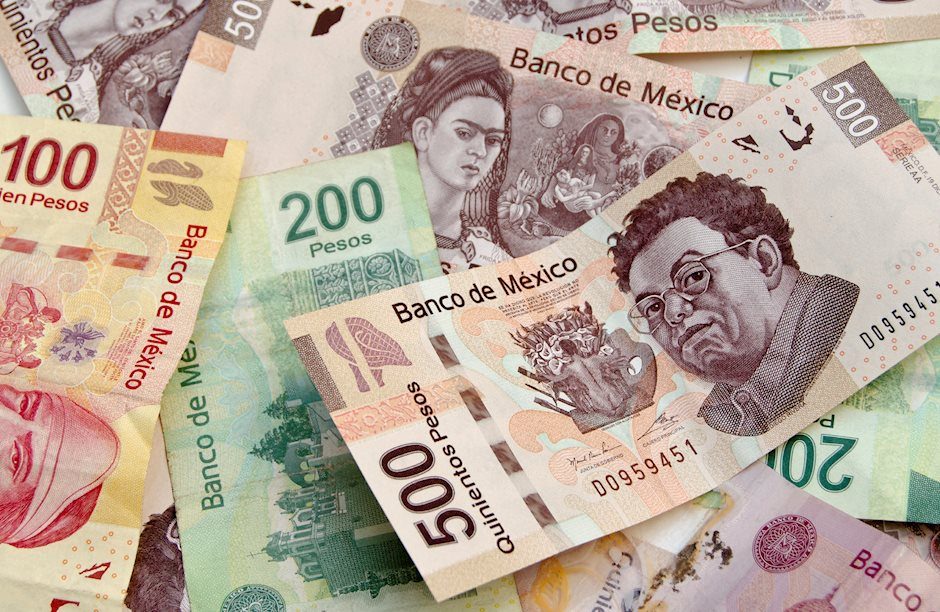Mexican Peso falls as Mexican Day of the Data draws near

For the latest news on the Mexican Peso click here.
- The Mexican Peso trades lower as traders await a slew of data about the Mexican economy on Thursday.
- The Peso witnessed a reversal on Tuesday that could reflect a change in sentiment.
- A widespread shift in interest rate expectations globally is supporting FX peers.
The Mexican Peso (MXN) trades lower in its key pairs on Wednesday, tag-teaming the sudden depreciation on the previous day which was probably due to a broad shift in global interest-rate expectations.
The changing outlook could narrow the advantage gap the Peso enjoys due to Mexico’s relatively high interest rates (11.00%), which are a draw for carry traders.
Mexican Peso traders are now gearing up for a Mexican "Day of the Data" party on Thursday, when a host of figures will be released updating them on the health of the nation’s economy.
At the time of writing USD/MXN is trading at 16.60, EUR/MXN at 18.04 and GBP/MXN at 21.18.
Mexican Peso suddenly depreciates in key pairs
The Mexican Peso’s sudden depreciation on Tuesday may be due to commentary from policymakers at several major central banks expressing a general reluctance to lower interest rates.
In the US, Federal Reserve speakers repeated the mantra that rates should remain at their current level until further progress had been made on inflation returning to its 2% objective.
On Wednesday, The Federal Open Market Committee (FOMC) Minutes for the May policy meeting will be released, which could offer new clues about US Federal Reserve (Fed) policymakers' interest rate outlook.
In Australia policymakers at the Reserve Bank of Australia (RBA) even discussed the possibility of raising interest rates to fight persistent inflation, and the Reserve Bank of New Zealand (RBNZ) executed a hawkish hold during the Asian session on Wednesday.
The anticipation of higher interest rates for longer strengthens these currencies as it attracts more foreign capital inflows.
Mexican Day of the Data
Mexican Peso traders now look forward to a slew of economic data releases for Mexico, which will be out on Thursday.
These include the final estimate for Mexican Gross Domestic Product (GDP) in Q1, 1st half-month Inflation for May, the Minutes of the Bank of Mexico’s (Banxico) last policy meeting and Economic Activity data for March.
Technical Analysis: USD/MXN forms bullish reversal day
USD/MXN – or the number of Pesos that can be bought with one US Dollar – continues higher on Wednesday after forming a bullish reversal day on Tuesday (shaded rectangle on the chart below).
USD/MXN Daily Chart
Tuesday’s movement is not enough to confirm a trend reversal, but if it is followed by another bullish close on Wednesday, it will gain validity.
A break above the green down trendline would be required to confirm a reversal of the short-term trend.
USD/MXN has now reached the conservative target – at 16.54 – for the breakdown out of the range that formed from mid-April to early May. The conservative estimate is calculated as the 0.618 Fibonacci ratio of the range's height extrapolated lower.
The pair remains in a downtrend and there is still a high risk of further bearishness taking it lower. The next downside target is 16.34, the full height of the range extrapolated lower. A break below the Tuesday low of 16.53 would signal a continuation lower.
Given the medium and long-term trends are also bearish, the odds further favor more downside.
Economic Indicator
Gross Domestic Product (YoY)
The Gross Domestic Product released by INEGI is a measure of the total value of all goods and services produced by Mexico. The GDP is considered as a broad measure of economic activity and health. Generally speaking, a high reading is seen as positive (or bullish) for the Peso, while a negative trend is seen as negative (or bearish).
Read more.Author

Joaquin Monfort
FXStreet
Joaquin Monfort is a financial writer and analyst with over 10 years experience writing about financial markets and alt data. He holds a degree in Anthropology from London University and a Diploma in Technical analysis.


















